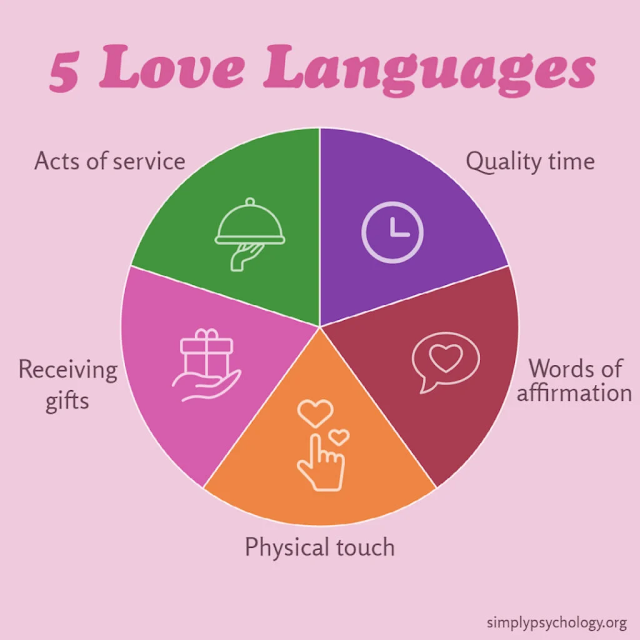While love is a universal language, we all have different ways of expressing and receiving it. Understanding these differences can significantly improve your relationships, making them more fulfilling and harmonious. This is where the concept of love languages comes in. Coined by Dr. Gary Chapman, love languages describe the different ways people give and receive love. In this blog, we'll dive into the five love languages, how to identify them, and practical tips for expressing love effectively in each language.
The Five Love Languages
1. Words of Affirmation
What It Is
For people who value words of affirmation, verbal expressions of love, appreciation, and encouragement are paramount. Compliments, kind words, and verbal acknowledgments make them feel cherished.
How to Express It
- Compliments: Say things like "You look great today" or "I really appreciate what you did."
- Encouragement: Offer supportive words like "You can do it" or "I believe in you."
- Acknowledgment: Simply acknowledging their efforts with a heartfelt "Thank you" can go a long way.
Dealing with It
If your partner values words of affirmation, make it a habit to express positive thoughts and feelings regularly. Write them a sweet note, send a thoughtful text, or simply tell them how much they mean to you.
2. Acts of Service
What It Is
Acts of service involve doing things you know your partner would appreciate, like chores, errands, or any tasks that make their life easier. Actions speak louder than words for people who value this love language.
How to Express It
- Household Chores: Help with cleaning, cooking, or other household tasks.
- Errands: Run errands or take care of responsibilities they might find stressful.
- Support: Offer help in times of need, such as bringing them a meal when they’re sick.
Dealing with It
Actions truly matter for someone who values acts of service. Look for ways to lighten their load regularly and show that you care through your deeds.
3. Receiving Gifts
What It Is
This love language is not about materialism but about the thoughtfulness and effort behind a gift. For people who value receiving gifts, the gift itself symbolizes love and appreciation.
How to Express It
- Thoughtful Gifts: Choose gifts that reflect their interests and preferences.
- Surprises: Surprise them with small, meaningful presents.
- Special Occasions: Remember birthdays, anniversaries, and other significant dates with a gift.
Dealing with It
Pay attention to what they like and surprise them with thoughtful gifts. It’s not about the price but the sentiment behind the gesture.
4. Quality Time
What It Is
Quality time is about giving someone your undivided attention. For people who value this love language, being present and engaged in shared activities is essential.
How to Express It
- Undivided Attention: Put away distractions and focus on them during conversations.
- Shared Activities: Spend time together doing things you both enjoy.
- Listening: Actively listen and engage in meaningful conversations.
Dealing with It
Ensure you set aside time to be with them without distractions. Plan regular date nights, engage in deep conversations, and be fully present when you’re together.
5. Physical Touch
What It Is
For those who value physical touch, tactile expressions of love, such as hugs, kisses, and holding hands, are crucial. Physical presence and accessibility are essential.
How to Express It
- Affectionate Touch: Hug, kiss, and hold hands often.
- Cuddling: Spend time cuddling on the couch or before bed.
- Gentle Touches: Simple gestures like a pat on the back or a touch on the arm can mean a lot.
Dealing with It
Make physical touch a regular part of your interactions. Show affection through touch and ensure they feel your physical presence and support.
How to Identify Your Love Language
To identify your love language, reflect on what makes you feel most loved and appreciated. Ask yourself:
- What do I often request from my partner?
- What makes me feel happiest and most secure?
- How do I usually express love to others?
You can also take the official love languages quiz available online to gain more insight into your primary love language.
Conclusion
Understanding and effectively expressing love in your partner’s love language can transform your relationship. It fosters deeper connections, reduces misunderstandings, and creates a more harmonious and loving bond. Remember, love is an ongoing journey, and learning to speak each other’s love language is a beautiful step toward a more fulfilling relationship.
FAQs
1. Can a person have more than one love language?
Yes, many people have a primary love language and a secondary one. Understanding and addressing all of them can enrich your relationship.
2. What if my partner’s love language is different from mine?
It’s common for partners to have different love languages. The key is to learn and practice each other’s love language to meet each other’s emotional needs.
3. Can love languages change over time?
Yes, love languages can evolve based on life experiences and circumstances. Regularly check in with your partner to ensure you’re meeting their current emotional needs.
4. How do I communicate my love language to my partner?
Have an open and honest conversation about your needs and preferences. Sharing your love language can help your partner understand how to make you feel loved and appreciated.










0 Comments